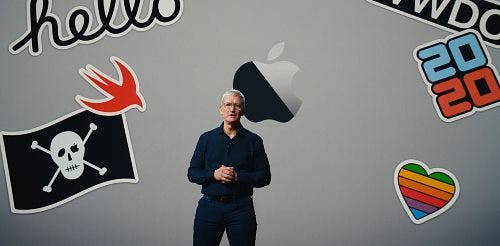CEO Tim Cook says it’s time for a huge leap forward for the Mac.
June 23, 2020

Apple just revealed a new Mac platform powered by its own CPUs instead of Intel’s x86 processors. The first Macs with Apple’s A12Z Bionic System on a Chip (SoC) are set to arrive by year’s end.
A new Mac platform, anticipated for some time, became official Monday during the kickoff of Apple’s Worldwide Developers Conference (WWDC).
Apple also revealed macOS Big Sur, which it described as the largest upgrade of its operating system in a decade. The new macOS Big Sur supports existing systems and the new Mac platform.

Apple’s Tim Cook discusses the new Mac platform at the virtual WWDC 2020.
“It truly is a historic day for the Mac,” said Apple CEO Tim Cook, during WWDC’s opening keynote session. As with all events during the current COVID-19 pandemic, Apple is holding this week’s annual developers’ conference online.
Keep up with the latest developments in how the channel is supporting partners and customers during the COVID-19 crisis. |
The company has only redesigned the Mac platform three times. The first was the shift to PowerPC, followed by the launch of macOS X. The third time Apple revamped the Mac was 15 years ago, with the move from PowerPC to Intel x86 processors.
“Now it’s time for a huge leap forward for the Mac,” Cook said.
Apple said its new silicon will deliver higher levels of performance, power management and capabilities such as artificial intelligence (AI). A new Neural Engine will offer a new machine learning platform for developers.
The company offered little detail about the makeup of the forthcoming new Macs with the new silicon. But it signals to partners and customers that Apple has ambitious plans for the Mac platform.
Revitalizing the Mac Partner Ecosystem
“What this tells us is that Apple has ambitions for their hardware and software that go far beyond the future capabilities of their vendors like Intel,” said Ryan Denehy, CEO of Electric AI, an MSP that manages 14,000 Macs.
The launch of the new Mac platform has major implications for the Apple partner ecosystem. By moving to its own silicon, the new Mac platform shares the same CPU architecture as its iPads, iPhones and the Apple Watch.
This will allow developers to build apps native to Apple Silicon. Apple launched a new version of its Xcode tool. The new Xcode 12 includes native compilers, editors and a debugger.
“To get started, developers just open their app projects and recompile,” said Craig Federighi, Apple’s SVP of engineering. “And the vast majority of developers can get their apps up and running in just a matter of days.”
A component of Xcode 12 called Universal 2, lets developers create apps for Intel-based Macs and the new Mac platform.
Here’s our most recent list of new products and services that agents, VARs, MSPs and other partners offer. |
“It’s a new type of universal binary that works on both Intel based Macs and Macs built on Apple silicon,” Federighi said. “Developers can tap into the native power and performance of our new Macs and still support Intel based Macs, all with a single binary for all of their users.”
Among those that have ported their software to the new Mac platform include Adobe and Microsoft, according to Apple.
Preparing Partners for the Transition
The company also is offering a similar translation technology it created when it shifted from PowerPC to Intel 15 years ago. Rosetta 2 lets users run existing Mac apps that software developers haven’t updated to the new Mac platform.
Partners that are members of the Apple Developer Program can apply for access the company’s Universal App Quick Start Program. It costs $500 and gives developers access to beta versions of the new macOS Big Sur and Xcode 12. The program also provides restricted use of an Apple developer toolkit (DTK) to build and test Universal 2 apps.
The DTK includes a Mac Mini with the new Apple A12Z Bionic SoC. The device, which Apple said partners must return at the end of the program, has a 512 GB SSD and 16 GB and various ports.
Read more about:
AgentsAbout the Author(s)
You May Also Like


